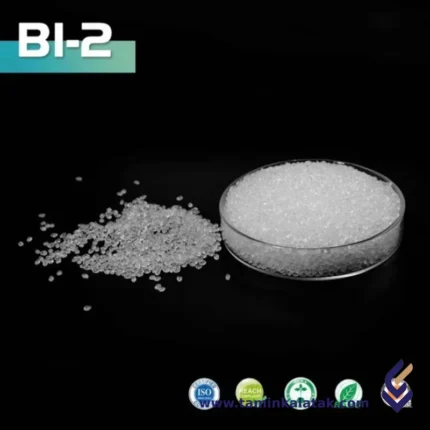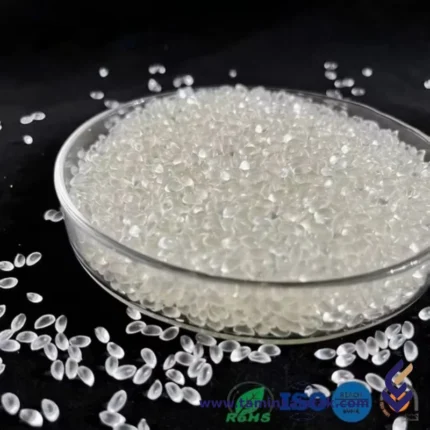Maleic Anhydride Grafted ABS
Maleic Anhydride Grafted ABS (ABS-g-MAH) is a modified version of Acrylonitrile Butadiene Styrene (ABS) in which maleic anhydride (MAH) is grafted onto the polymer chain. This modification enhances the compatibility of ABS with polar polymers, fillers, and reinforcements, making it especially useful in applications requiring improved adhesion and interfacial bonding.
Structure Maleic Anhydride Grafted ABS
Maleic Anhydride Grafted ABS (ABS-g-MAH) consists of the standard ABS polymer backbone, which includes acrylonitrile, butadiene, and styrene, with maleic anhydride chemically grafted onto it. The grafting process typically occurs through reactive extrusion or radical polymerization, where maleic anhydride molecules attach to the butadiene or styrene segments of the ABS chain. This modification introduces polar functional groups into the otherwise non-polar ABS matrix, improving its compatibility with polar polymers, fillers, and reinforcements. The presence of maleic anhydride provides reactive sites that enhance adhesion and interfacial bonding in polymer blends and composites. While the primary structure of ABS remains intact, the grafted maleic anhydride groups contribute to increased polarity, making the material more suitable for applications requiring better dispersion of fillers, improved adhesion to coatings, and enhanced mechanical properties in polymer blends.Properties Maleic Anhydride Grafted ABS
Maleic Anhydride Grafted ABS (ABS-g-MAH) consists of an Acrylonitrile Butadiene Styrene (ABS) backbone with maleic anhydride (MAH) grafted onto it through reactive processing methods such as melt grafting or solution grafting. The structure retains the original ABS polymer framework, which comprises styrene and acrylonitrile phases dispersed in a rubbery butadiene matrix, but the addition of maleic anhydride introduces polar functional groups onto the polymer chains. The grafting process typically occurs through radical polymerization, where free radicals generated on the ABS backbone react with maleic anhydride, leading to covalent attachment. The maleic anhydride groups primarily bond to the butadiene segments or sometimes to the styrene portions, enhancing the polarity of the material. This structural modification improves compatibility with polar polymers such as polyamides and polycarbonates, increases adhesion to fillers and reinforcements, and enhances interfacial interactions in polymer blends, making ABS-g-MAH a valuable compatibilizer and adhesion promoter in various engineering applications.Applications Maleic Anhydride Grafted ABS
- Polymer Blends & Alloys – Enhances compatibility in blends like ABS/PA, PC/ABS, and ABS/PBT.
- Adhesion Promoter – Improves bonding with coatings, paints, adhesives, and metals.
- Compatibilizer in Composites – Enhances dispersion of fillers like glass fibers, talc, and carbon nanotubes.
- Automotive Industry – Used in bumpers, interior panels, and structural components requiring toughness and adhesion.
- Electronics & Electricals – Applied in enclosures, connectors, and parts requiring improved thermal and mechanical stability.
- Packaging & Consumer Goods – Improves adhesion in multilayer packaging films and functionalized plastic parts.
Advantages Maleic Anhydride Grafted ABS
- Improved Compatibility – Enhances adhesion between ABS and polar polymers or reinforcements.
- Increased Adhesion – Strong interfacial bonding with fillers, coatings, and other polymers.
- Enhanced Mechanical Properties – Better impact resistance, toughness, and thermal stability.
- Better Processability – Allows easier blending with other polymers and additives.
- Chemical Resistance – More resistant to environmental stress and certain chemicals compared to standard ABS.
Disadvantages Maleic Anhydride Grafted ABS
- Higher Cost – More expensive than standard ABS due to additional processing.
- Reduced Thermal Stability – The grafting process can sometimes lower the thermal stability of ABS.
- Possible Degradation – Maleic anhydride groups may undergo hydrolysis over time, affecting performance.
- Limited Availability – Not as widely available as standard ABS, which may affect sourcing.
Maleic Anhydride Grafted POE
Maleic anhydride grafted polyolefin elastomer (MAH-g-POE) is a functionalized elastomer where maleic anhydride is grafted onto a polyolefin elastomer (POE) backbone. This modification enhances compatibility with polar materials and improves adhesion in polymer blends and composites.
Structure Maleic Anhydride Grafted POE
Maleic anhydride grafted polyolefin elastomer (MAH-g-POE) is a modified polymer where maleic anhydride (MAH) functional groups are chemically grafted onto a polyolefin elastomer (POE) backbone through reactive extrusion or other grafting methods. The polyolefin elastomer provides flexibility, impact resistance, and good compatibility with polyolefin-based materials, while the maleic anhydride groups introduce polar functionalities that improve adhesion, compatibility, and interfacial interactions with polar materials such as polyamides, polyesters, and fillers. The grafting process typically involves the use of an initiator, such as a peroxide, to generate free radicals that facilitate the attachment of MAH onto the POE chains. This modification enhances the polymer’s ability to act as a compatibilizer, impact modifier, or coupling agent in various applications, including toughening engineering plastics, enhancing adhesion in composite materials, and improving dispersion of fillers in polymer matrices. The degree of grafting and molecular weight of the base POE influence the final properties of the material, allowing it to be tailored for specific applications in industries such as automotive, packaging, and adhesives.Properties Maleic Anhydride Grafted POE
Maleic anhydride grafted polyolefin elastomer (POE-g-MAH) is a modified polymer known for its excellent adhesion, compatibility, and impact resistance. It retains the flexibility and toughness of polyolefin elastomers while incorporating reactive maleic anhydride groups that enhance its bonding ability with polar materials such as polyamides, polyesters, and fillers. This modification improves interfacial adhesion in composite materials, making it highly effective as a compatibilizer in polymer blends and fiber-reinforced composites. POE-g-MAH exhibits good thermal stability, chemical resistance, and weatherability, making it suitable for applications in automotive, packaging, and electrical industries. Additionally, it maintains excellent impact strength at low temperatures and provides improved processing performance due to its enhanced compatibility with other polymers.Applications of Maleic Anhydride Grafted POE (POE-g-MAH)
- Compatibilizer in polymer blends – Improves adhesion between polyolefins and polar polymers like polyamide (PA) and polypropylene (PP).
- Automotive industry – Used in bumpers, dashboards, and structural components for enhanced toughness and durability.
- Adhesives and coatings – Enhances bonding with polar substrates, improving adhesion strength.
- Thermoplastic elastomers – Used to modify elastomers for better mechanical properties.
- Wire and cable insulation – Provides improved flexibility, toughness, and weather resistance.
- Packaging materials – Enhances impact resistance and processability in multilayer films.
- Fiber-reinforced composites – Improves interfacial adhesion and toughness in composite materials.
Advantages of POE-g-MAH
- Excellent impact resistance – Maintains toughness even at low temperatures.
- Enhanced compatibility – Improves bonding between non-polar and polar polymers.
- Good thermal stability – Suitable for high-temperature applications.
- Chemical and weather resistance – Performs well in outdoor and harsh environments.
- Improves polymer blends – Enhances toughness without significantly reducing rigidity.
Disadvantages of POE-g-MAH
- Higher cost – More expensive compared to unmodified POE.
- Limited adhesion to highly polar polymers – May require further modification for specific applications.
- Lower stiffness and strength – May not match the mechanical properties of engineering plastics.
Maleic anhydride grafted TPE
Maleic anhydride grafted thermoplastic elastomer (TPE-g-MA) is a modified thermoplastic elastomer in which maleic anhydride (MA) is grafted onto the polymer backbone. This modification introduces polar functional groups that enhance adhesion, compatibility with polar materials, and chemical reactivity, making it valuable in various applications.
Structure Maleic anhydride grafted TPE
Maleic anhydride grafted thermoplastic elastomer (TPE-g-MA) consists of a thermoplastic elastomer backbone with maleic anhydride groups randomly grafted onto the polymer chains. The base TPE can be a styrenic block copolymer, polyolefin-based elastomer, or other TPE types, depending on the intended application. The maleic anhydride groups introduce polar functionalities while maintaining the inherent elasticity and flexibility of the TPE. These anhydride groups are covalently bonded to the polymer backbone through a free radical grafting process, often initiated by peroxide or other radical initiators. The resulting structure has both nonpolar and polar regions, improving adhesion, compatibility with polar materials, and reactivity for further chemical modifications. This makes the material especially useful in polymer blends, composites, and adhesion-promoting applications.Properties Maleic anhydride grafted TPE
Maleic anhydride grafted thermoplastic elastomer (TPE-g-MA) retains the inherent flexibility, elasticity, and processability of the base TPE while gaining enhanced polarity and reactivity due to the grafted maleic anhydride groups. This modification improves adhesion to polar substrates, increases compatibility with polar polymers such as polyamides and polyesters, and enhances dispersion in composite materials. The material exhibits excellent mechanical properties, including good tensile strength, elongation, and impact resistance, while maintaining a soft and rubber-like feel. Its thermal stability remains similar to that of the base TPE, though the grafting process may slightly alter its flow characteristics. The maleic anhydride groups introduce reactive sites that can interact with amines, hydroxyl groups, and other nucleophiles, making it suitable for further chemical modifications. Additionally, the material provides improved resistance to environmental stress cracking and better bonding performance in over-molding applications, making it ideal for use in adhesives, coatings, automotive components, and polymer blends.Advantages Maleic anhydride grafted TPE
- Enhances adhesion to polar materials such as metals, glass, and engineering plastics.
- Improves compatibility in polymer blends, especially with polar polymers like polyamides and polyesters.
- Retains the flexibility, elasticity, and processability of the base thermoplastic elastomer.
- Provides reactive sites for further chemical modifications, such as bonding with amines or hydroxyl-containing compounds.
- Increases interfacial adhesion in composite materials, improving mechanical properties.
- Offers good resistance to environmental stress cracking and durability in demanding applications.
- Can be processed using standard thermoplastic methods like extrusion, injection molding, and blow molding.
Disadvantages Maleic anhydride grafted TPE
- Slightly altered thermal and flow properties compared to unmodified TPE.
- The grafting process can lead to some variability in material properties depending on the degree of modification.
- The presence of maleic anhydride groups may make the material more sensitive to hydrolysis in humid conditions.
- Can have a higher production cost compared to non-grafted TPE due to additional processing steps.
Applications Maleic anhydride grafted TPE
- Polymer Blends and Compatibilization: Enhances adhesion in blends of TPE with polar polymers such as polyamides, polyesters, and polycarbonates.
- Adhesives and Sealants: Used in structural bonding, pressure-sensitive adhesives, and hot-melt adhesive applications.
- Automotive Components: Improves bonding in multi-material parts, vibration damping, and soft-touch overmolding.
- Medical Devices: Provides flexibility and strong adhesion in biocompatible applications.
- Coatings and Surface Treatments: Used as an adhesion promoter for paints, coatings, and primers.
- Consumer Goods and Footwear: Enhances durability, flexibility, and adhesion in over-molded products.
- Wire and Cable Insulation: Improves adhesion to polar substrates and enhances mechanical performance.









